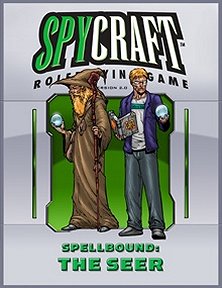
Spellbound: The Seer is part of a series that allows the incorporation of magic into a Spycraft 2.0 game. Each volume presents a 'school' of magic and a corresponding base class for those magicians who wish to practise it. In this one, we meet the Seer, described as a student of mystery, master of secrets, and wielder of devastating words of power... if you are running a Spycraft game that allows for the supernatural and magical powers, this could be an interesting and potent addition to the classes available to your players... and probably great fun as an NPC too!
The supplement begins with some general remarks about having magic in your game, beginning with the need to set it as a campaign quality and then choosing which schools of magic exist in your setting. The discussion moves on to some thought-provoking ideas as to how magic might work - what's the source, how do you access and use it, what does it look like and what are the consequences of loosing magic on your world? Once you come up with your own answers to these questions, you have gone a long way to doing the groundwork to embed magic into your game.
There are some differences to 'standard' D20 magic, such as you find in Dungeons and Dragons. You make a skill check to cast each spell, for example, and can cast any spell you know without preparation provided you have sufficient power. Oh, and you can be wearing whatever you want, and various other changes. It makes for a simple and straightforward set of mechanics to underpin spellcasting.
Right, here we are looking at the 'Seer School' of magic, which has three strands or disciplines, being artifice, divination and word. Artifice is about exerting control over machinery, divination is about detecting things and observing even at a distance and word is using the very language of magic to sometimes devastating effect. Thus introduced, all that you need to generate a Seer character is provided. Depending on how you choose to interpret it (and several suggestions are given) a Seer ought to be a source of wise counsel to his colleagues, a practical ideas man for the party. He's an interesting character, with high skill points, a well-rounded class skill list, strong progressions, and a spell list that can create offensive, defensive, knowledge and crafting effects.
Next, the whole process of spellcasting using these rules is explained. Basically, it is a 'spell point' system where the caster expends a set number of points based on the spell he wants to cast. The points he has is based on his level and they refresh every scene (unless he is still maintaining a long-running spell, when he doesn't get the points powering that spell back). Normally spellcasting is quite noticeable (you need a Sleight of Hand check if you try to conceal what you are up to, and they still might notice the mumbling - you have to be able to speak to cast). You also need a 'spell kit' - the equivalent of the infamous 'material components' required of a D&D wizard - although its up to you and the GC to determine just what you need to have with you to cast effectively.
Once you have all that in hand, there are some magic-related feats to choose from and a goodly array of spells... as well as sufficient information on how they are put together to let you construct your own if you are that way inclined. The collection of spells just begs to be tried out and could provide a very interesting spin on an otherwise conventional Spycraft game if you decide to let magic in!
It's an intriguing proposition and one that could make for some memorable ones. Try it if you dare.
Return to Spellbound: The Seer page.
Reviewed: 4 February 2015

